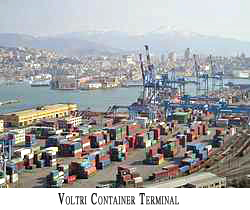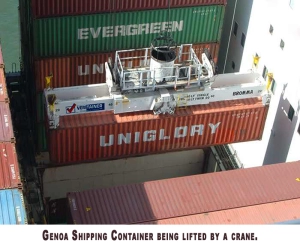Tales from the Nuclear Age
Copyright © 2011 by Charles Glassmire
______________________________________________________________
Dec. 24, 2011
Radioactive Borders
The city of Genoa lies quietly at the northern-most tip of the Italian Mediterranean coastline. The historic center of this ancient city, home to winding narrow streets of fascinating architecture,  hosts a profusion of narrow passageways and charming staircases to be explored by the interested tourist. The robust city walls are interspersed with medieval gates, revealing the many hillside churches and a city center of aging hills.
hosts a profusion of narrow passageways and charming staircases to be explored by the interested tourist. The robust city walls are interspersed with medieval gates, revealing the many hillside churches and a city center of aging hills.
A few kilometers from this ancient center of Genoa rests one of the largest maritime ports in all of Italy. Since the 15th century, the city has sent sailors across the oceans, even training one navigator named Christopher Columbus. This seafaring tradition has generated a life-supporting business of ocean trade.
One section of this port, at the western end, is named Voltri Terminal Europa. Built to receive the large shipping containers  offloaded there by the world’s commercial fleets, the seaport boasts an annual trade volume of over 58 million tonnes. The quay is routinely cluttered with the large cargo containers, each measuring 20 feet long by 8 feet square, stacked up like bricks in some gigantic fortress wall.
offloaded there by the world’s commercial fleets, the seaport boasts an annual trade volume of over 58 million tonnes. The quay is routinely cluttered with the large cargo containers, each measuring 20 feet long by 8 feet square, stacked up like bricks in some gigantic fortress wall.
It was on the morning of July 13, 2010, when inspector Enzo Montagna, a certified radiation inspector, set up his Geiger counter on the dock about sixty feet away from a stack of eleven cargo containers.
He had been summoned there as an independent contractor, to do his usual routine check of those containers designated for inspection. Each day the dock supervisor examines the container manifests and decides which ones should be set aside for increased scrutiny and possible radiation testing. This is a government requirement before these units may be opened and their contents distributed throughout the country.
The shipping cargo container has revolutionized the world’s commercial sea trade business, and made the distribution of foods such as grain, fast and economical. In the “old days” a group of stevedores would offload a ships cargo placing each item onto wooden palettes stacked alongside the docked vessel. This method could easily take one full week to unload a cargo ship.(1) Today, in a staggering reversal of conditions, six men can use a crane to offload 24 containers per hour, emptying a ship of 3000 boxes in only a few days.(1) It’s fast and incredibly less expensive.
These sealed steel boxes arrive from distant ports all over the globe. During loading a list of the contents is declared, the container  is then locked and sealed with a twisted wire and ceramic button, and the unit is then loaded aboard a vessel bound for ports around the world. Sometimes a unit is “transshipped”, meaning it is sent to an intermediate port, moved from one vessel to another which is bound directly to its destination port, without opening or review of its contents. This paper shuffle can sometimes obscure the originating port and/or the original shipping company. Once that container arrives at its destination port no one really knows what is inside, and only the box manifest contains any clue as to its contents.
is then locked and sealed with a twisted wire and ceramic button, and the unit is then loaded aboard a vessel bound for ports around the world. Sometimes a unit is “transshipped”, meaning it is sent to an intermediate port, moved from one vessel to another which is bound directly to its destination port, without opening or review of its contents. This paper shuffle can sometimes obscure the originating port and/or the original shipping company. Once that container arrives at its destination port no one really knows what is inside, and only the box manifest contains any clue as to its contents.
Philip Spayd, a former U.S. government security consultant, says
“We know what’s represented on their documents, but those documents are easily faked…The only people who really know what’s inside are the ones who were there when the container was packed.”(1)
He says containers are used to smuggle every kind of contraband, including narcotics, cash, guns and, surprisingly – people. Not too long ago a foreign national was discovered in a cargo container shipped across the United States border. He had set up a living space inside the unit, complete with sleeping bag, inflatable mattress, food and water and a portable toilet. He had a [false] Canadian passport and had survived the journey nicely, until his unfortunate discovery by alert border officials. He did not show for his court hearing and has since disappeared from sight.
The possibilities are ominous for the United States. Modern nuclear weapons have been reduced to a size easily carried in a heavy backpack. One could simply be concealed among the legitimate cargo items in one of these shipping containers; once inside the country it could be loaded onto a local trucking company vehicle and simply delivered to a pseudo company run by terrorists in any U.S. city. Estimates vary of the total number of shipping containers crossing the U.S. borders each day, running from 30,000 to 45,000 cargo containers per day entering the United States!(2) The U.S. maritime system consists of over 300 sea and river ports with more than 3,700 cargo and passenger terminals.(3)
Another possibility for terrorist attack is much simpler to transport in a shipping container. It’s called an RDD (Radiological Dispersion Device), or “dirty bomb”. This device is much simpler to execute than a full nuclear weapon. It’s just a radioisotope such as Cobalt 60 embedded with an ordinary explosive such as TNT. The (non-nuclear) explosive is detonated and radioactive material is scattered around a local area and disbursed by local winds, contaminating a small local area and causing terror.
So now we return our story to our radiation inspector, Enzo Montagna, setting up his radiation detector on a windy morning in the Voltri Terminal in Genoa, in order to check out eleven cargo containers marked for special inspection. He is using a low range Geiger Counter, capable of detecting even small amounts of gamma radiation. At this distance (60 feet) only gamma rays could exist, since the particle radiations, alpha and beta particles, would be blocked by the thick metal sides of the shipping container.
He sets the meter to the lowest most sensitive range and turns on the power. Surprisingly, the needle swings all the way to the right and pegs on maximum. No problem, this is a very small quantity detected, and he simply switches to the next higher scale (10 times higher) but is surprised to see the needle once again pegged at maximum. The device earphones are now emitting and ear piercing screech, where normally a single count is registered by a simple beep. On the highest range, 500 times greater – the needle is still pegged, indicating his body is being bathed by a radiation field far higher than normal background level. He runs to his vehicle parked nearby, and retrieves a high-range meter, capable of detecting dangerous levels of gamma radiation. This meter also sings out an ear splitting wail and on the lowest scale again pegs the needle.
This seems to indicate a high radiation source of gamma rays bathing the dock and his body with dangerous amounts of ionizing radiation …
(To be continued …)
________________________________________________________________
(1) “Mystery Box”, by Andrew Curry, Wired Magazine, November 2011, pp188.
(2) “Incentives for private industry, risk-based inspection for cargo containers”, Homeland Security News Wire, 22 Feb. 2010 – 11:13.
(3) “Port Security”, Wikipedia, 25 Mar. 2011.
Leave a comment